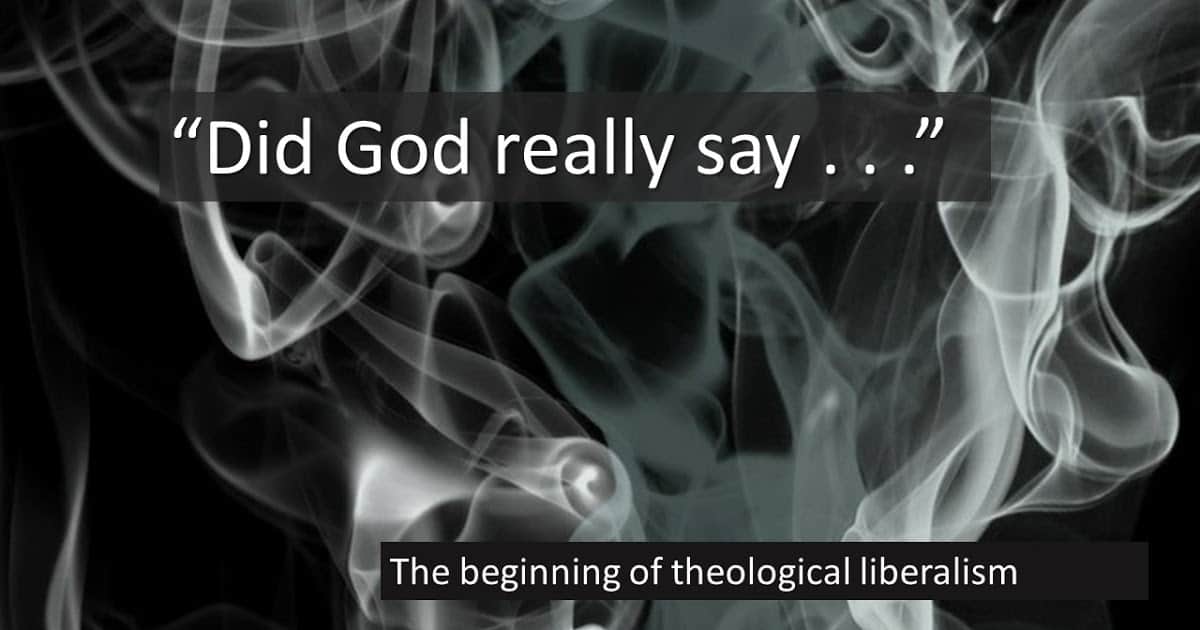In this 127th episode of CS, titled “Then Away,” we give a brief account of the rise of Theological Liberalism.
In the previous episodes, we charted the revivals that marked the 18th and 19th centuries. Social transformation is a mark of such revivals. But not all those engaged in the betterment of society were motivated by a passion to serve God by serving their fellow Man. At the same time that revival swept though many churches, others stood aloof and held back from being carried away into what they deemed as “religious fanaticism.”
As Enlightenment ideas moved into and through the religious community, some theologians shifted to accommodate what had become the darling ideas of academia. Instead of becoming outright agnostics, they sought to wed rationalism with theology and arrived at an amalgam we’ll call Theological Liberalism.
Not to be outdone by Revivalists transforming culture through the power of The Gospel and a conviction they were to be salt and light in a dark and decaying world, Liberalism developed what came to be called The Social Gospel; a faith that emphasized doing as much, if not more than, believing.
The name most associated with the Social Gospel is Walter Rauschenbusch. He began pastoring a Baptist church in New York in 1886. It was there that he came face to face with the desperate condition of the poor. He joined the faculty of Colgate-Rochester Theological Seminary, where over the course of 10 years he wrote 3 books that were hugely influential in promoting the Social Gospel.
Someone might say at this point >> You’ve used that phrase a couple of times now. What’s ‘The Social Gospel’?”
The Social Gospel was a movement among Protestant denominations in the early 20th century, mainly in the United States and Canada, but a limited expression in Europe. It addressed social problems with Christian ethics. Its main targets were issues of social justice like poverty, addiction, crime, racism, pollution, child labor, and war. Advocates of the Social Gospel sought to implement that line in the Lord’s Prayer that says, “Your Kingdom Come, Your will be done, on Earth as it is in Heaven.”
Advocates of the Social Gospel were usually post-millennialists who believed the Second Coming would not occur unless humanity rid itself of injustice and vice. The leaders of the movement were largely connected to the liberal wing of the Progressive Movement.
The Social Gospel movement peaked in the early 20th century. It began to decline due to the trauma brought about by WWI, when the ideals of the movement were so badly abused by world events. A couple of under-pinnings of theological liberalism are the Brotherhood of Man and the innate goodness of human beings. WWI conspired to prove the lie to both assumptions and create doubt in the minds of millions that humans are good or could be a brotherhood.
Though Rauschenbusch’s early theology included a belief in original sin and the need for personal salvation, by the time he’d written his last tome, he regarded sin as an impersonal social ill and taught that reform would arrive with the demise of capitalism, the advance of socialism, and the establishment of the Kingdom of God by human effort. His views were accepted by such prominent spokesmen as Shailer Matthews and Shirley Jackson Case of the University of Chicago.
Rauschenbusch’s impact was combined with other developments in liberalism during the 19th century. Unitarianism had made deep inroads into mainline denominations under the leadership of William Ellery Channing and Theodore Parker. Channing’s sermon “Unitarian Christianity” in 1819, deserves credit for launching the Unitarianism movement.
Another influential figure of the 19th C was Horace Bushnell. He published Christian Nurture in 1847, arguing that a child ought to grow up in covenant with God, never knowing he was anything but a Christian. This was contrary to the Pietist emphasis on having a datable conversion experience. Bushnell’s ideas of growing a child up from birth in a covenant of grace had a huge impact on Christian educators for generations.
In addition to Theodore Parker’s support of Unitarianism, he introduced German biblical criticism into American Christianity. By doing so, the way was opened for Darwinian evolution and the ideas of Julius Wellhausen. Wellhausen was one of the originators of the Documentary Hypothesis, which forms the core of much of modern liberal scholarship on the Bible to this day.
These influences led to a creeping theological liberalism based on the twin postulates of the evolution of religion and a denial of the supernatural. In their place emerged the idea of the Fatherhood of God, the Brotherhood of Man, and the establishment of God’s Kingdom as a natural outcome of evolution.
Three German scholars were also central to the development of Theological liberalism: Schleiermacher, Ritschl, and Harnack.
Friedrich Schleiermacher adapted the ideas of Existentialism to Christianity and said that the core of faith wasn’t what one believed so much as what one FELT, what we experience. Religion, he urged, involved a feeling of absolute dependence on God. For Schleiermacher, doctrine hung on experience, not the other way around. Today, a mature Christian might counsel a neophyte, saying something like, “Don’t let feelings control you.” Or, “We need to evaluate our experiences by God’s Word, not the other way around.” Schleiermacher would disagree with that. In his view, experience VALIDATES doctrine. Feels are key. A Faith that isn’t felt is no faith at all, he maintained.
Albert Ritschl claimed Christ’s death had nothing to do with the payment of a penalty for sin. He said it resulted from loyalty to His calling of bringing about the Kingdom of God on Earth, and that it was by His death that He could share his experience of Sonship with all people, who would then become the vehicle and means by which the Kingdom could be constructed. The practice of a communal religion was of vital importance to Ritschl because Christ best shared Himself through the community of the Church. Ritschl’s impact on other scholars was great.
Probably the most affected by Ritschl’s works was Adolf Harnack. Harnack regarded the contributions of the Apostle Paul to the Gospel as a Greek intrusion on the Christian Faith. His goal was to get back to a more primitive and Jewish emphasis that centered on ethical imperatives as opposed to doctrine. As a professor in Berlin in 1901 he published his influential What Is Christianity? This focused on Jesus’ human qualities, who preached not about Himself but about the Father; the Kingdom and the Fatherhood of God; a higher righteousness; and the command to love.
The views of these three German scholars came ashore in America to further the liberal ideas already underway.
If Theological Liberalism with its Social Gospel were a reaction to the Revivals of the 18th and 19th centuries, those who’d been revived were not going to sit idly by as that liberalism grew. They responded with a movement of their own.
Charles Briggs, a professor at Union Theological Seminary in New York, was put on trial before the Presbytery of New York and suspended from ministry in 1893 for promulgating liberal ideas. Henry Smith of Lane Seminary in Cincinnati was likewise defrocked that same year, as was AC McGiffert for holding and teaching similar views. Other denominations had heresy trials and dismissed or disciplined offenders. The most famous conflict of the 20th century concerned Harry Emerson Fosdick, who in 1925 was removed as pastor of First Presbyterian Church of New York City to became an influential spokesman for liberalism as the pastor of Riverside Church.
Roman Catholicism wasn’t immune to the impact of theological liberalism and reacted strongly against it. Alfred Loisy, founded Roman Catholic Modernism in France, but was dismissed in 1893 from his professorship at the Institut Catholique in Paris. He was further excommunicated in 1908. The English Jesuit George Tyrrell was demoted in 1899 and died out of fellowship with the church. Liberalism invaded American Roman Catholicism. To silence the threat, Pope Pius X issued the decree Lamentabili in 1907, and in 1910 he imposed an anti-modernist oath on the clergy.
In contest with Liberalism, Evangelicals had a number of able scholars during the latter part of the 19th and early part of the 20th centuries. Charles Hodge defended a supernaturally-inspired and inerrant Bible during his long tenure as professor of biblical literature and theology at Princeton. AA Hodge carried on his father’s work. In 1887, BB Warfield followed Hodges as professor of theology. Fluent in Hebrew, Greek, modern languages, theology, and biblical criticism, Warfield staunchly defended the inerrancy of Scripture and basic evangelical doctrines in a score of books and numerous pamphlets. In 1900, the scholarly Robert Dick Wilson joined the Princeton faculty, and J Gresham Machen [Mah khen] arrived shortly after. In 1929, when a liberal realignment occurred at Princeton, Machen and Wilson joined Oswald Allis, Cornelius Van Til, and others in founding Westminster Theological Seminary. Other scholars could be mentioned, but these were some of the most prestigious.
This movement came to be known as Fundamentalism; a word with a largely negative connotation today as it conjures up the idea of wild-eyed religious fanatics who advocate violence as a means of defending and promulgating their beliefs. Christian Fundamentalism was simply a theologically conservative movement that sought to preserve and articulate classic, orthodox beliefs on the essentials of the Christians Faith. They were called Fundamentals because they were regarded as those doctrines essential to the integrity of the Gospel message; things that had to be believed in order to be saved.
Fundamentalism was largely a reaction to Theological Liberalism which appeared to many Evangelicals to be taking over the colleges and seminaries. Liberalism wasn’t popular with the average church-goer. It founds it’s base among academics and those training clergy. But evangelical leaders knew what began in classrooms would soon be preached in pulpits, then practiced in pews. So they began the counter-movement called Fundamentalism.
Since Theological Liberals had already managed to co-opt the chairs of many institutions of higher learning, they cast their Fundamentalist opponents as uneducated and unsophisticated nincompoops. Knuckle-dragging theological Neanderthals who couldn’t comprehend the complexities of higher criticism and the latest in theological research. That image has, for many, become part and parcel of the connotative meaning of the word Fundamentalist today. And it’s grossly unfair since those early Evangelical scholars who shaped the Fundamentalist movement were some of the brightest, best-educated, and most erudite people of the day.

